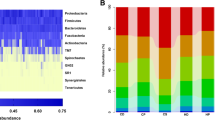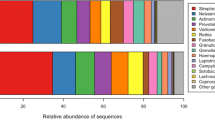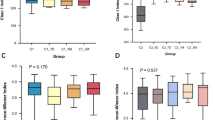Abstract
Background
Dental caries develops as a result of the metabolism of carbohydrates by cariogenic bacteria present in a complex biofilm. The present study aimed to examine if bacteria in pooled supragingival plaque samples quantified using a “checkerboard DNA-DNA hybridization” based panel of caries-related bacteria, could reflect the caries experience in a manner similar to saliva samples analysed using a chair-side method in a previous investigation.
Methods
A total of 86 mothers and their children aged 4–6 years and 12–16 years old participated. Caries experience (DMFT/dmft; Decayed, Missing and Filled Teeth for permanent and primary teeth) was registered clinically and radiographically. Caries was recorded at the D3 level (caries into dentine). The D/d component was divided into three categories. A pooled supragingival plaque sample per participant was obtained from posterior approximal sites. Analyses of 15 bacterial species were performed using the checkerboard DNA-DNA hybridisation technique.
Results
No significant relationships were found between the bacterial scores and DMFT/dmft nor D/d groups.
Conclusions
Unlike the saliva samples and the chair-side method, interproximal pooled plaque samples analysed using the “checkerboard DNA-DNA hybridization technique” did not reveal any significant relations between the bacterial counts and the caries experience.
Similar content being viewed by others
Background
Dental caries is a multifactorial disease initiated and influenced by a number of key factors [1]. In addition, saliva plays an important role in maintaining the teeth integrity by buffering acids produced by cariogenic bacteria and protecting teeth from decay. Saliva may influence the oral microflora by adsorbing to the tooth surface forming the acquired pellicle, which determines which microorganisms are able to attach and colonize [2]. Saliva has been conventionally used as a diagnostic tool to determine individual caries activity and risk [3, 4]. Such assessment includes the recording of salivary buffer capacity and counts of cariogenic bacteria mainly mutans streptococci and lactobacilli using chair-side tests.
Although salivary analysis may provide a general overview of the oral ecology reflecting the caries risk, dental caries is principally a biofilm-induced disease [5]. Viewing this biofilm (dental plaque) as a complex microbial ecosystem has enhanced the understanding of its role in caries development and progression [6]. Cariogenic plaques result when acidogenic and aciduric bacterial species increase following high frequency carbohydrate exposure. The microbial metabolism of such carbohydrates will result in the acidification of the biofilm, which in turn may lead to acid-induced demineralization of the dental hard tissues [6]. One of the molecular techniques that have demonstrated the diverse microbial composition of the dental biofilm is the “checkerboard DNA-DNA hybridisation technique” [7, 8]. However, no caries-specific panel has yet been proposed. It would therefore be interesting to use the checkerboard DNA-DNA hybridisation technique with a caries specific panel to investigate the relationship between individual caries experience and the counts of different caries-related supragingival plaque bacteria.
The present study was performed as part of a series of studies on Saudi mothers and their children. One part aimed at describing the caries experience in relation to various caries-related factors and a clear association between chair-side salivary bacterial counts and caries experience was found [9]. Another part was designed to determine if pooled interproximal plaque samples analysed using the “checkerboard DNA-DNA hybridisation technique” could reflect the caries experience.
The hypothesis of this cross-sectional study is that higher caries experiences are associated with higher counts of caries-related bacteria in supragingival plaque. The aim of the present study was therefore to examine if bacteria in pooled supragingival plaque samples quantified using a “checkerboard DNA-DNA hybridization” based panel of caries-related bacteria, could reflect the caries experience in a manner similar to saliva samples analysed using a chair-side method in a previous investigation.
Methods
Subjects
The study was given ethical approval by the Faculty of Dentistry at King Abdulaziz University in Jeddah, Kingdom of Saudi Arabia. The dental records at the Dental Health and Emergency Clinics at the Faculty of Dentistry were screened to identify suitable family candidates. The study comprised 86 volunteer families. From each family, the mother (mean age 37.0 ± 4.5 years) and two of her children, aged 4–6 years old (mean age 5.0 ± 0.9 years) and 12–16 years old (mean age 13.0 ± 1.4 years) volunteered. Verbal information about the study was given to the parents and written informed consent was obtained. All the investigations were carried out by one of the authors (AM).
Caries registration
The dentition status was expressed using the DMFT index (Decayed, Missing and Filled Teeth) for permanent teeth and dmft for primary teeth. Third molars were excluded. Caries was registered clinically and radiographically at the D3 level [10]. Bitewing radiographs were taken for each participant in order to record approximal decay. All the approximal surfaces in the dentition from the mesial surface of the first premolars/primary molars to the distal surface of the second molars/primary molars were included.
Bacterial plaque samples
Pooled supragingival plaque was sampled from the approximal sites between teeth 16/15, 25/26, 35/36 and 46/45 in the mothers and older children and teeth 55/54, 64/65, 74/75 and 85/84 in the younger children using sterile Gracey curettes. If one of the teeth in the approximal site was missing, an adjacent site was used. Each plaque sample was placed in an Eppendorf tube containing 150 μ l of sterile TE buffer (10 mM Tris–HCl, 1 mM EDTA, pH 7.6). Then 100 μ l of 0.5 M NaOH was added to the plaque pellet and the bacterial suspension was stored at -20°C pending further processing [11].
Checkerboard DNA-DNA hybridisation
The analysis of bacterial species was performed using the checkerboard DNA-DNA hybridisation method [12]. Whole genomic probes were prepared from the 15 bacterial strains known to be related to caries as shown in Table 1. An evaluation of the bacterial count in the samples was performed by comparing the obtained signals with the ones generated by the pooled standard samples containing a count of 106 and 105 of each bacterial species, respectively. The signals were coded on a scale from 0 to 5 as follows: 0 = no signal; 1 = a signal density weaker than that of the low standard (<105 bacteria); 2 = a signal density equal to that of the low standard (=105 bacteria); 3 = a signal density higher than that of the low standard but lower than that of the high standard (>105 but <106 bacteria); 4 = a signal density equal to that of the high standard (=106 bacteria) and 5 = a signal density higher than that of the high standard (>106 bacteria). Further details regarding the technique are found in Mannaa et al. [13]. All the assessments were performed by one examiner (AM).
Data analysis
All data were analysed using the IBM® SPSS® statistical package (PASW version 18.0, IBM®, Chicago, Ill., USA). The D/d component was categorised into low: ≤ 1, medium: 2–5 and high: > 5 for the mothers and older children, and low: ≤ 3, medium: 4–9 and high: ≥ 10 for the younger children. Cohen’s Kappa for the determination of the intra-examiner reliability of the caries registration was calculated. Descriptive statistics, including the means and standard deviations were calculated separately for the three groups. Regarding the checkerboard scores, only a few signal “0” data were recorded and therefore combined with signal “1” data into “≤1”. One-way ANOVA was used to compare mean differences in the caries experience in relation to the bacterial scores. Fisher’s exact test was used to associate the D/d groups with the bacterial scores. The level of statistical significance was set at 5%.
Results and discussion
The Cohen’s kappa values for the caries registration for the mothers, younger children and older children were 0.88, 0.90 and 0.82 respectively. Table 2 summarizes the bacterial counts for each species. The caries experiences (DMFT/dmft) of the mothers, younger and older children are summarised in Table 3.
There was an un-equal distribution of subjects within the scores on the checkerboard scale, with the majority of bacterial counts in the lower ranges of the scale. The analysis showed no relation between the bacterial scores and the caries experience for any of the caries-related bacteria. In addition, no significant associations were detected between the bacterial scores and the D/d categories in the mothers or in their younger or older children except for a tendency observed in relation to Streptococcus mutans as shown in Table 4.
The majority of studies using the checkerboard DNA-DNA hybridisation technique have focused on studying plaque bacterial ecology in relation to periodontal disease [14–17]. These studies revealed a directly proportional relationship between the bacterial count and periodontal pocket depth. The present study could not demonstrate a relationship between the counts of supragingival bacteria and the caries experience (DMFT/dmft). A relationship between caries experience and caries-related salivary bacterial counts (mutans streptococci and lactobacilli) assessed using CRT Bacteria® was found in the same study sample [9]. In the present study, no relationship between the bacteria quantified in the pooled plaque samples and the caries experience was found. This corresponds well with an earlier study where a stronger association between dental caries and cariogenic organisms analysed by culture technique in comparison to the checkerboard method was found [18]. A number of factors related to the characteristics of dental plaque, the caries disease process and the choice of sampling method, may explain the current finding. The bacterial interaction in dental plaque could make a greater contribution to caries development than the specific count of certain cariogenic species. In addition, the plaque microbial community differs at different stages of plaque maturation (early plaque versus mature plaque). Furthermore, the location of the sampling sites and number of sites selected may influence the relationship. The count of plaque bacteria could also be affected by a number of caries-related factors other than the actual caries experience such as the location/depth (enamel versus dentine), stage (incipient versus cavitated), level (acute, chronic or arrested), and activity of the carious lesion (active versus inactive). Furthermore, the checkerboard DNA-DNA hybridisation technique has a high cut-off limit for bacterial quantification making the detection of bacteria in low counts problematic, which may be further complicated by cross-reactions [19]. Finally, the unequal distribution of subjects within the checkerboard scores with a majority of low bacterial counts in the present study could account for the lack of significant results.
In addition to the previously mentioned drawbacks, there are two limitations of the sampling method used in the present study. Unlike with saliva, it is difficult to standardize the amount of bacteria in a plaque sample. Standardization can be easily achieved with saliva by expressing the amount of bacteria in a 1-mL sample. Furthermore, pooling supragingival plaque into one test tube may create difficulties in lysing all bacterial cells present in a very dense bacterial suspension [20]. For this reason, heavy plaque sampling was minimized in the present study by taking only a sufficiently visible amount of supragingival plaque. However, the question whether too little plaque was collected cannot be ruled out.
Contrary to the present study, Aas et al. showed that higher counts of specific bacterial species were associated with health, caries initiation, and caries progression by using a reverse-capture essay [21]. Moreover, the present study analysed pooled plaque samples as opposed to samples from different caries-susceptible sites in the oral cavity. In addition, the DMFT/dmft index could be regarded as a crude method to describe the individual caries experience and conveys no information about caries activity. A relationship between plaque bacterial counts and caries experience may have been obtained if the investigation had been performed on a site-specific level and if caries-related parameters such as depth, stage and activity had been taken into consideration.
Conclusions
Unlike the saliva samples and the chair-side method, interproximal pooled plaque samples analysed using the “checkerboard DNA-DNA hybridization technique” did not reveal any significant relations between the bacterial counts and the caries experience.
References
Selwitz RH, Ismail AI, Pitts NB: Dental caries. Lancet. 2007, 369: 51-59. 10.1016/S0140-6736(07)60031-2.
Marsh PD, Martin MV: Dental plaque. Oral Microbiology. 2009, Churchill Livingstone Elsevier, 74-102. 5
Tenovuo J: Salivary parameters of relevance for assessing caries activity in individuals and populations. Community Dent Oral Epidemiol. 1997, 25: 82-86. 10.1111/j.1600-0528.1997.tb00903.x.
Slots J, Slots H: Bacterial and viral pathogens in saliva: disease relationship and infectious risk. Periodontol 2000. 2011, 55: 48-69. 10.1111/j.1600-0757.2010.00361.x.
Marsh PD, Moter A, Devine DA: Dental plaque biofilms: communities, conflict and control. Periodontol 2000. 2011, 55: 16-35. 10.1111/j.1600-0757.2009.00339.x.
Filoche S, Wong L, Sissons CH: Oral biofilms: emerging concepts in microbial ecology. J Dent Res. 2010, 89: 8-18. 10.1177/0022034509351812.
Socransky SS, Smith C, Martin L, Paster BJ, Dewhirst FE, Levin AE: “Checkerboard” DNA-DNA hybridization. Biotechniques. 1994, 17: 788-792.
Socransky SS, Haffajee AD, Smith C, Martin L, Haffajee JA, Uzel NG, Goodson JM: Use of checkerboard DNA-DNA hybridization to study complex microbial ecosystems. Oral Microbiol Immunol. 2004, 19: 352-362. 10.1111/j.1399-302x.2004.00168.x.
Mannaa A, Carlén A, Lingström P: Dental caries and associated factors in mothers and their preschool and school children – A cross-sectional study. J Dent Sci. 2013, in press
Pitts NB: Modern concepts of caries measurement. J Dent Res. 2004, 83 (Spec Iss C): C43-47.
Gellen LS, Wall-Manning GM, Sissons CH: Methods in Molecular Biology. 2007, Totowa, NJ: Humana Press Inc, 39-67. Checkerboard DNA–DNA Hybridization Technology Using Digoxigenin Detection, Protocols for Nucleic Acid Analysis by Nonradioactive Probes,
Wall-Manning GM, Sissons CH, Anderson SA, Lee M: Checkerboard DNA-DNA hybridisation technology focused on the analysis of Gram-positive cariogenic bacteria. J Microbiol Methods. 2002, 51: 301-311. 10.1016/S0167-7012(02)00106-9.
Mannaa A, Carlén A, Dahlén G, Lingström P: Intra-familial comparison of supragingival dental plaque microflora using the checkerboard DNA-DNA hybridisation technique. Arch Oral Biol. 2012, 57: 1644-1650. 10.1016/j.archoralbio.2012.06.016.
Ximénez-Fyvie LA, Haffajee AD, Socransky SS: Comparison of the microbiota of supra- and subgingival plaque in health and periodontitis. J Clin Periodontol. 2000, 27: 648-657. 10.1034/j.1600-051x.2000.027009648.x.
Haffajee AD, Socransky SS, Patel MR, Song X: Microbial complexes in supragingival plaque. Oral Microbiol Immunol. 2008, 23: 196-205. 10.1111/j.1399-302X.2007.00411.x.
López R, Dahlén G, Retamales C, Baelum V: Clustering of subgingival microbial species in adolescents with periodontitis. Eur J Oral Sci. 2011, 119: 141-150. 10.1111/j.1600-0722.2011.00808.x.
Dahlén G, Konradsson K, Eriksson S, Teanpaisan R, Piwat S, Carlen A: A microbiological study in relation to the presence of caries and calculus. Acta Odontol Scand. 2010, 68: 199-206. 10.3109/00016351003745514.
Hintao J, Teanpaisan R, Chongsuvivatwong V, Ratarasan C, Dahlen G: The microbiological profiles of saliva, supragingival and subgingival plaque and dental caries in adults with and without type 2 diabetes mellitus. Oral Microbiol Immunol. 2007, 22: 175-181. 10.1111/j.1399-302X.2007.00341.x.
Socransky SS, Haffajee AD, Cugini MA, Smith C, Kent RL: Microbial complexes in subgingival plaque. J Clin Periodontol. 1998, 25: 134-144. 10.1111/j.1600-051X.1998.tb02419.x.
Papapanou PN, Madianos PN, Dahlén G, Sandros J: “Checkerboard” versus culture: a comparison between two methods for identification of subgingival microbiota. Eur J Oral Sci. 1997, 105: 389-396.
Aas JA, Griffen AL, Dardis SR, Lee AM, Olsen I, Dewhirst FE, Eugene JL, Paster BJ: Bacteria of dental caries in primary and permanent teeth in children and young adults. J Clin Microbiol. 2008, 46: 1407-1417. 10.1128/JCM.01410-07.
Pre-publication history
The pre-publication history for this paper can be accessed here:http://www.biomedcentral.com/1472-6831/13/5/prepub
Acknowledgements
We would like to thank Ann-Britt Lundberg (Department of Cariology, University of Gothenburg) and Susanne Blomqvist (Department of Oral Microbiology and Immunology, University of Gothenburg) for their technical support. Special thanks to Dr. Nadia Al-Hazmi, head of dental records and filing, Dr. Sahar Bukhary, head of the Oral Biology Division, and Dr. Motaz Ghulman, Vice Dean of student affairs at the faculty of dentistry at KAU, Kingdom of Saudi Arabia. The study was supported by the Saudi Ministry of Higher Education.
Author information
Authors and Affiliations
Corresponding author
Additional information
Competing interests
The authors report no conflicts of interest.
Authors’ contributions
AM participated in the study design, carried out data collection and sampling, ran the “Checkerboard DNA-DNA Hybridization” analysis, performed statistical analysis and was responsible for the manuscript writing. AC participated in the study design and supervised the manuscript writing. GC assisted in the statistical analysis and helped to draft the manuscript. PL participated in the study design and supervised the manuscript writing. All authors read and approved the final manuscript.
Anette Carlén, Guglielmo Campus and Peter Lingström contributed equally to this work.
Rights and permissions
This article is published under license to BioMed Central Ltd. This is an Open Access article distributed under the terms of the Creative Commons Attribution License (http://creativecommons.org/licenses/by/2.0), which permits unrestricted use, distribution, and reproduction in any medium, provided the original work is properly cited.
About this article
Cite this article
Mannaa, A., Carlén, A., Campus, G. et al. Supragingival plaque microbial analysis in reflection to caries experience. BMC Oral Health 13, 5 (2013). https://doi.org/10.1186/1472-6831-13-5
Received:
Accepted:
Published:
DOI: https://doi.org/10.1186/1472-6831-13-5




